Learn to Sing: Acoustic and Laryngeal Registration

ACOUSTIC AND LARYNGEAL REGISTRATION
Registration or vocal registers can be defined as changes in vocal timbre across a singer’s range. When we mix, we attempt to equalize that timbre throughout the range, so there is no abrupt change in vocal quality anywhere in the range.
Prior to this chapter, when we talked about lower register and upper register, we were referring to the vocal folds, or more specifically, the length of the folds and the degree of TA muscle activity on any given pitch. We learned about the distinction between short/thick vocal folds (M1- lower register) vs. lengthened/thinned vocal folds (M2-upper register). This is laryngeal registration.
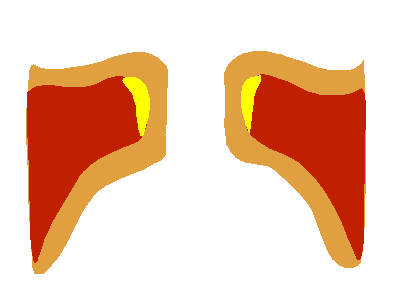
This is how your vocal folds work in the lower register. Air coming from the lungs creates a vibrational wave in the folds that begins from the bottom of the fold and travels to the top. The folds open and close rapidly, converting aerodynamic energy to acoustic energy. When you sing a middle C, this happens 256 times per second, also known as Hertz.

Images by Reinhard (Public Domain) via Wikimedia Commons
When you are singing higher notes in your upper register, this vibratory pattern begins higher on the vocal fold. The folds are lengthened, thinner, and tauter due to the cricothyroid muscles (CT) tilting the thyroid cartilage forward and down.
Because the folds are attached to the arytenoid cartilages in the back of the larynx, when the thyroid tilts forward and down the folds are lengthened like rubber bands stretching. When this happens, there is less vocal fold vibrational mass employed in the production of tone.
Pitch is controlled by the length of the vocal folds. Shorter folds=looser mucosa and lower pitch. Longer folds=tauter folds and higher pitch.
However, there is another factor involved in registration- that of acoustics. Acoustic registration affects laryngeal registration.
Acoustic registration refers to the relationship between formants and harmonics; laryngeal registration refers to the balance of TA and CT muscle activity.
Acoustic registration is how the vocal tract boosts or damps (attenuates) harmonics generated by the vocal folds.
The vibrating vocal folds produce frequencies called harmonics. Air in the containers (the pharynx and mouth) of the vocal tract vibrates at frequencies determined by the size and shape of the container. Frequencies are pitches.
Air in the vocal tract, vibrating at a certain pitch, is known as a formant. When the frequency of one or more formants aligns with one or more of the harmonics generated from the vocal folds, the sound is boosted in volume, stability, and energy.
A resonance strategy is making specific vowel and vocal tract choices to align formants with nearby harmonics. Resonance strategies determine how well a singer will transition through passaggi and they determine timbre for style in singing. In singing, we employ either a first formant resonance strategy or a second formant resonance strategy.
This means that either the first formant or the second formant boosts certain harmonics close to their frequency vicinity. The specific harmonics boosted determine the timbre or tone color of the resultant sound.
The first formant plays a major role in timbre. Two of the many timbres or sound qualities we can produce are the called out hey! or w[o] in the lower register (Step Two), and the high call or whoop, w[u]-[i] in the upper register (Step Three).
TIMBRE IN THE LOWER REGISTER
If you loudly call out to your neighbor across the street HEY!, you are employing a first formant resonance strategy. The first formant is the pitch of the air in the pharynx, the area between the vocal folds and the constriction or hump of the tongue. In this call-out mode, the first formant couples with the second harmonic (F1/H2) to create a brassy, strong quality.
A TA-dominant vocal fold posture creates squared vocal folds that meet at the bottom, generating many strong higher harmonics that are close together. This is the sound of the lower register or chest voice.
When two or more harmonics are at or below F1, the timbre is bright, mouthy, brassy, open, speech-like.
F1/H2 Coupling
Male D4: Lower Register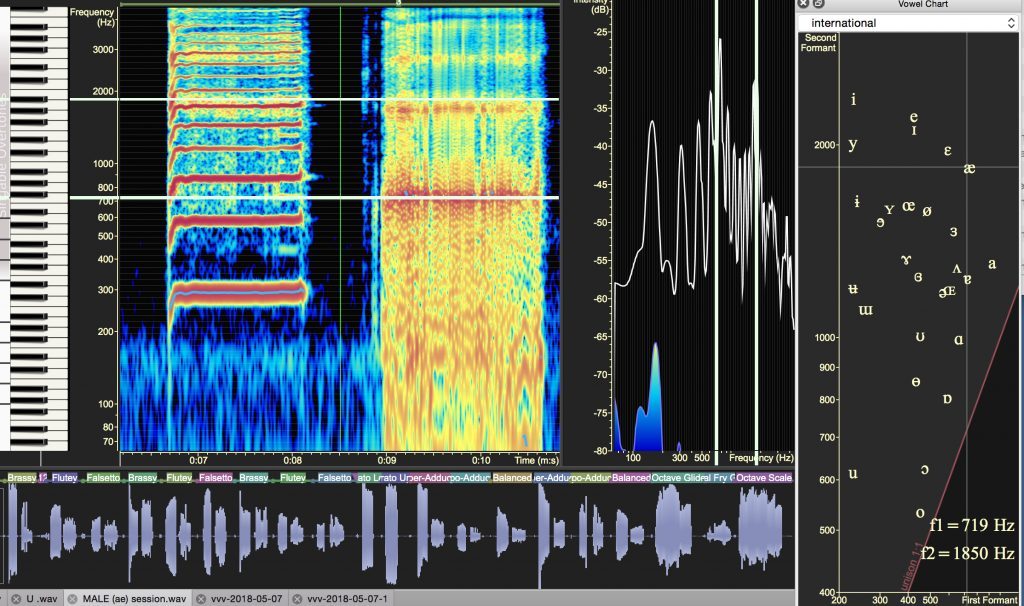
YELL MODE
If the F1/H2 coupling is taken too high in pitch, (beyond the primo passaggio or first bridge) we get a yell, or pulled chest. To hold on to the yell mode, a singer must shorten the pharyngeal tube by activating the swallowing muscles and lifting the larynx, thus raising F1 frequencies to track the rising second harmonic H2 frequencies.
This creates a smaller pharynx but a larger mouth opening, the divergent resonator shape. We can only accomplish this on open vowels like [ɑ], [æ] and [ɛ], with their intrinsically higher F1 frequencies. The TA muscles are very active (dominant) in this type of phonation (mode 1).
You can see how F1 and H2 are coupled in the example of yell mode below.
Yell Mode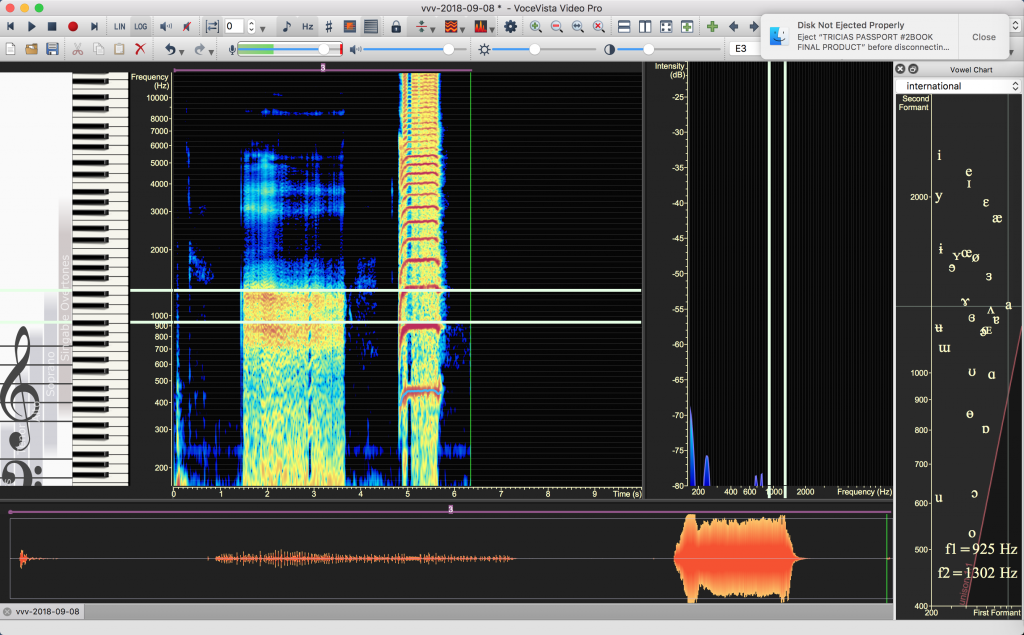
TIMBRE IN THE UPPER REGISTER: LEGIT
When the first formant (F1) couples with the first harmonic (H1), also known as the fundamental, or pitch, we get what Kenneth Bozeman calls the whoop timbre. This is the sound of the classical soprano.
In the upper register, lengthened vocal folds, less TA myscle activation and less vocal fold mass (mode 2), produce fewer upper harmonics, which are weaker and spaced more widely apart. The resonator shape is convergent- larger in the back and smaller in the front.
The upper register whoop is the sound you make when you say YOO-HOO! like French chef Julia Child.
In the image below of a female singer in whoop mode, you can see the F1 frequencies are closest to F0/H1, the fundamental. This gives her the hooty classical timbre.
In Step Three of the Eight Steps of Vocal Development, we use the F1/H1 resonance strategy with our High Call w[u]-[i] exercises to develop the upper register (whoop). We use the [u] and [i] vowels here because of their low F1 frequency.
F1/H1 Coupling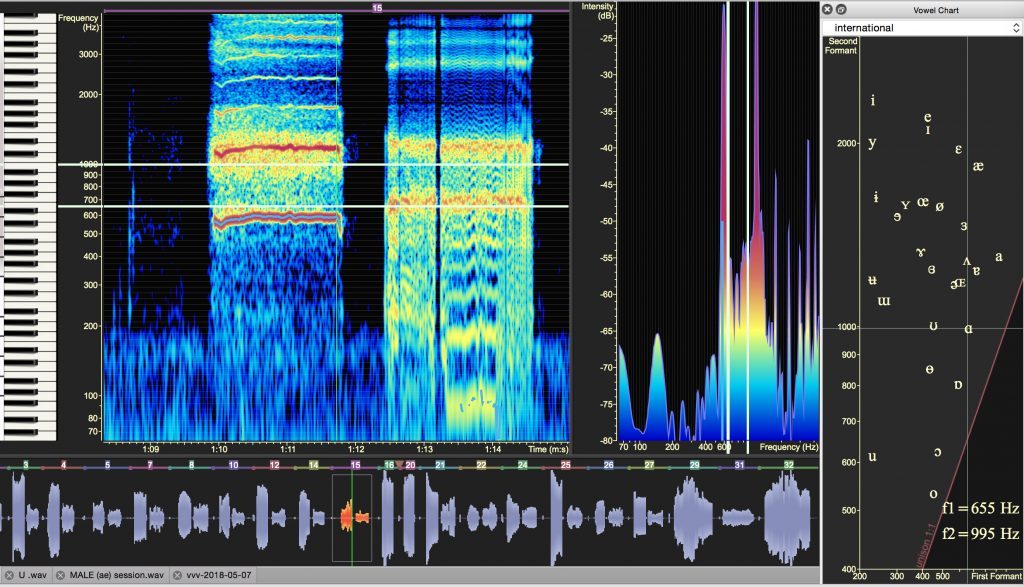
TIMBRE IN THE UPPER REGISTER: MIX
In the upper register mix, the second formant boosts H3 ,H4 ,and higher harmonics.
Male Mix at Bb4 [æ]
In this example the second formant couples with the fourth harmonic.
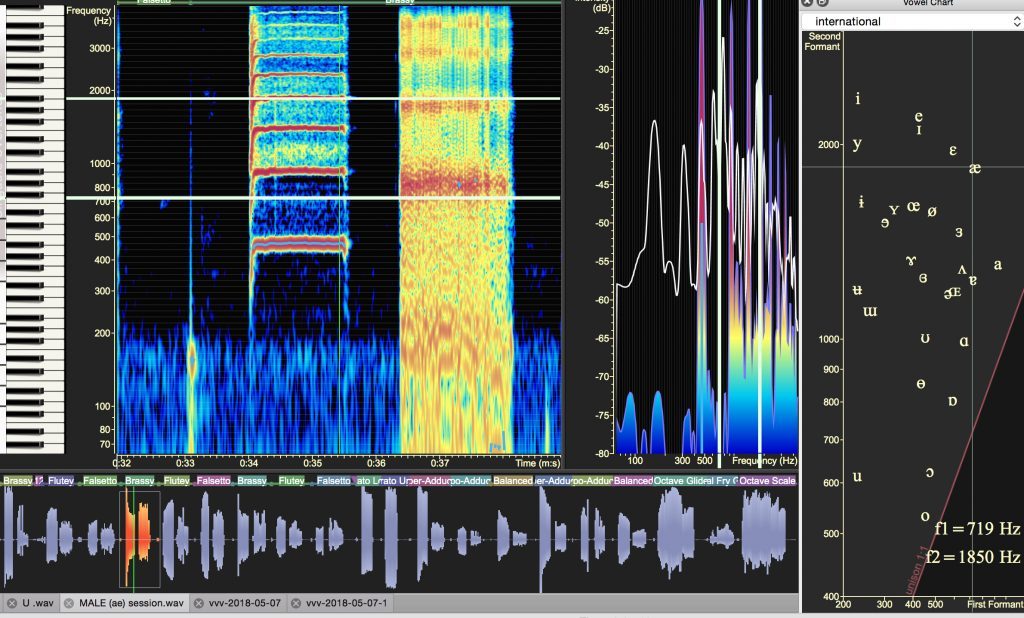
If you would like to learn more about your voice AND learn to sing from home for less than you probably spend for lattes every month, check out our amazing YOU can Sing Like a Star online subscription courses for singers and voice teachers.
You can learn to sing with a self-study method- IF it's the right method. The ONLY method that can take you from beginner to professional is the YOU can Sing Like a Star online subscription course with over 600 recorded exercises.
This is the best method available and the ONLY method that takes you all the way from beginner to professional singer- for far less than the cost of in-person voice lessons!
Check this amazing course out at YOU can Sing Like a Star online subscription course.
If you are a voice teacher who wants to up your game, check out the YOU can be a Successful Voice Teacher online subscription course
With over 600 recorded exercises, including Riffs and Runs- Style, you don't need to be a great pianist or vocal stylist to be a great teacher!



